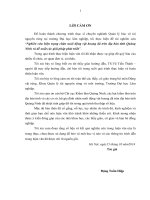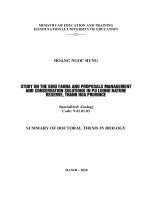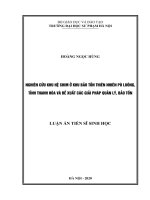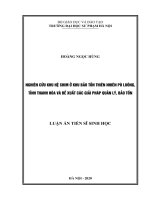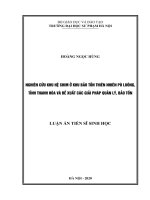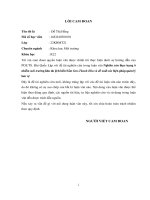Nghiên cứu khu hệ chim ở khu bảo tồn thiên nhiên pù luông, tỉnh thanh hóa và đề xuất các giải pháp quản lý, bảo tồn tt tiếng anh
Bạn đang xem bản rút gọn của tài liệu. Xem và tải ngay bản đầy đủ của tài liệu tại đây (430.01 KB, 26 trang )
MINISTRY OF EDUCATION AND TRAINING
HANOI NATIONAL UNIVERSITY OF EDUCATION
------------
HOANG NGOC HUNG
STUDY ON THE BIRD FAUNA AND PROPOSALS
MANAGEMENT AND CONSERVATION SOLUTIONS
IN PU LUONG NATURE RESERVE, THANH HOA
PROVINCE
Specialized: Zoology
Code: 9.42.01.03
SUMMARY OF DOCTORAL THESIS IN BIOLOGY
HANOI - 2020
Thesis was completed at:
Hanoi National University of Education
Advisors: 1. Ass. Prof. Dr. NGUYEN LAN HUNG SON
2. Dr. NGUYEN CU
Reviewer 1: Ass. Prof. Dr. Nguyen Xuan Huan
(VNU University of Sciences)
Reviewer 2: Ass. Prof. Dr. Nguyen Quang Truong
(Institute of Ecology and Biological Resources)
Reviewer 3: Ass. Prof. Dr. Nguyen Thien Tao
(Vietnam national museum of nature)
The thesis will be reviewed by the council of thesis evaluation at the
Department psychology – education, Hanoi National University of
Education
at ........on ..../...../2020
The thesis can be found at:
- National Library
- Hanoi National University of Education Library
1
INTRODUCTION
1. Research rationales
Pu Luong Nature Reserve is located in the northwest of Thanh
Hoa province, in the territory of Quan Hoa and Ba Thuoc District
with a section planning area of 17,171.53 ha. Pu Luong Nature
Reserve is the first point of forest ecosystems on Pu Luong limestone
mountain - Cuc Phuong - Ngoc Son. This natural forest ecosystem
has high biodiversity values, with many endemic plant and animal
species. Pu Luong Nature Reserve, located in the North Central
region is in 221 endemic bird regions of the world. It is also one of 4
endemic bird areas (EBA) of Vietnam. Landscape of the Pu Luong
Nature Reserve forms part of the region's endemic bird area Central
Vietnam lowland. However, Pu Luong Nature Reserve still lacks of
systematic and comprehensive research about bird fauna, which is
reliable scientific basis for planning, management, conservation and
sustainable development of prices Treating bird resources here. For the
above reasons, we propose to implement the project: "Study on the
bird fauna and proposals management and conservation solutions in
Pu Luong Nature Reserve, Thanh Hoa province”.
2. Research aims
Determining the species diversity, composition and distribution
of the bird fauna; analyzing relationship in ecology of the bird fauna in
Pu Luong Nature Reserve. Besides, evaluating the current status and
propose solutions for sustainable management, conservation and
development of bird resources in the study area.
2
3. Research content
- Study on bird species diversity in Pu Luong Nature Reserve.
- Study on distribution of bird fauna in Pu Luong Nature Reserve;
especially determine distribution of rare and precious bird species.
- Study on the bird fauna status and factors which are
affecting bird fauna in Pu Luong Nature Reserve. Therefore,
propose sustainable management and conservation solutions for
bird fauna in the reserve.
4. New points of the thesis
- For the first time, the thesis has studied more fully and
comprehensively on bird composition in Pu Luong Nature Reserve
with 252 species, 58 families and 15 orders; added 74 additional new
recorded species for bird list in Pu Luong Nature Reserve and 30 new
recorded species for bird list in the North Central region compared to
the "Vietnam bird list" by Vo Quy and Nguyen Cu (1999).
- The thesis has analyzed the ecological relationship of bird
communities in 5 major habitats in the nature reserve, including:
evergreen forest; secondary forest, secondary grass and shrubs,
plantation forest and upland fields, fields and villages; analyzed the
relationship of the bird community according to the forest canopy
and observing the change of bird species in the Pu Luong Nature
Reserve throughout season.
- Based on research results, the thesis has proposed to build 4
eco-tourism routes, especially bird-watching in Pu Luong Nature
Reserve; identify priority areas of high value conservation birds for
monitoring programs; provide information on the status of conservation
value birds in Pu Luong Nature Reserve.
3
CHAPTER 1
LITERATURE REVIEW
1.1. History of bird research in North Central and Study Area
- Previous research on bird fauna in North Central Vietnam
According to Vo Quy and Nguyen Cu (1995), the North
Central region includes Thanh Hoa, Nghe An and Ha Tinh
provinces. Associated with historical landmarks of Vietnam, history
of bird research in the North Central region can be summarized as
three main stages: before 1945, from 1945 to 1954, from 1957 until
now.
Before 1945, most of studies on birds in Vietnam and Indochina
were carried out by foreign scientists such as Linneus (1758), Gmelin
(1788), Oustalet (1899-1903). Especially, from 1924 to 1938,
Delacour and his colleagues organized 07 rounds of bird collection on
Indochina territory, including the North Central region.
From 1945 to 1954, due to the war, all bird research activities
in Vietnam were interrupted and only started again in 1957.
Since 1957, after North Vietnam gained independence, domestic
scientists have began to focus on biodiversity, including birds.
Typical Vietnamese scientists in this period include: Vo Quy, Nguyen
Cu, Tran Gia Huan, Le Dien Duc, Do Ngoc Quang, Truong Van La,
Le Dinh Thuy... In general, the bird research projects in the region
North Central in this period has just stopped at building a list of
species in the National Parks, Nature Reserve, despite going into the
4
studies on biology, ecology of avifauna as well as analyzing the
features about the area in the study area.
- Pu Luong Nature Reserve: In 1997, Le Trong Trai
identified the Pu Luong bird fauna with 169 bird species belonging
to 41 families and 13 orders. In 2013, the project investigated and
listed the flora and fauna of Pu Luong Nature Reserve, which had
recorded the presence of 908 animal species, including 117 bird
species. At the same time, 93 species of birds of conservation value
were identified. In addition to the survey of bird species, there are a
number of surveys and studies for conservation activities such as:
investigating the situation of illegal hunting of wild animals and
collection of non-timber forest products. Hoang Lien Son (2003)
belongs to the landscape conservation project of Pu Luong - Cuc
Phuong
limestone
conservation
project
mountains;
-
Integrated
Community-based
management
natural
and
resource
management strategy in Pu Luong Nature Reserve of the
International Wildlife Conservation Organization.
1.2. Overview of the natural conditions of the study area
- Geographical location: Pu Luong Nature Reserve has
geographical coordinates 20021’- 20034’ Northern latitude, 105002’ 105020’ east longitude, located in the northwest of Thanh Hoa
province, in the territory of two districts of Quan Hoa and Ba Thuoc.
- Topography and geomorphology: Pu Luong Nature Reserve,
which is composed of 2 mountain ranges running parallel in the
Northwest-Southeast direction, is separated from each other by a
5
large valley. The small mountain range in the southwest is made up
mainly of eruptive magma and metamorphic rocks. The large
mountain range is located in the northeast in Co Lung and Lung Cao
communes formed from limestone.
- Flora: Pu Luong Nature Reserve has 1,109 species, 477
genera and 152 families of vascular plants; Vegetation cover includes
primary forest, secondary forest, tropical shrub grassland (distributed
at elevations below 700 m), subtropical (distributed at elevations
above 700 m). Currently, the pristine area in Pu Luong Nature Reserve
is strongly reduced to only about 5% of the forest area.
- Animal system: In 2013, the project "Investigation, listing of
fauna and forest flora in Pu Luong Nature Reserve, Thanh Hoa
province" identified 908 animal species, of which: 67 species, 21
families and 6 orders; insects have 347 species, 80 families and 17
orders; amphibians have 26 species, 7 families; reptiles have 40
species, 14 families, 2 sets; The bird has 117 species, 43 families and
13 orders; animals have 79 species, 24 families and 9 orders.
1.3. Overview of socio-economic conditions in the study area
- Population, labor, employment and income: In the Pu
Luong Nature Reserve boundary, there are 387 households living
with 1,800 people in Co Lung and Lung Cao communes, Ba Thuoc
district. The inhabitants are mainly Thai and Muong ethnic people;
the buffer zone has 4,850 households with 22,500 inhabitants living
in 7 communes of 2 districts Quan Hoa and Ba Thuoc; The labor
force accounts for about 40% of the total population. Income of
6
people is mainly from agriculture (previously relying on forest). The
average income per capita is VND 2,500,000/person/year.
CHAPTER 2
MATERIALS AND METHODS
2.1. Time and study location
- Study location: Pu Luong Nature Reserve, Thanh Hoa
province with geographical coordinates: 20021” - 20034” North
latitude and 105002” - 105020” East longitude. Location of research
locations is shown in Figure 2.1.
Figure 2.1: Diagram of bird research sites in Pu Luong
7
- Study time: The project was implemented in 4 years (from
October 2014 to October 2018) with 14 field surveys in 152 days in
8 research areas. Each study area has 2 locations for translucent nets
and bird observation.
2.2. Research Methods
- Observation of wild birds: 16 research locations have shown in
Figure 2.1. Birds are observed with binoculars, field scope tubes. In
addition, use of telephoto-mounted cameras, Nikon Coolpix P900
superzoom cameras for remote bird photography.
- Catching - dropping mist-nets: Mist nets used to study are 4handed, 6 and 12 m long, 2.6 m high, 15 x 15 mm mesh (net
produced by Italy. Each research site often uses 10-12 nets).
- Interview local people: To get more information for the field
survey process, we also interviewed people who are managers of
protected areas, forest rangers, commune management and people
used to hunt.
- Identification of bird species: During the field survey as well
as interviews with local people, the books with photos or color
drawings illustrated to quickly identify birds in Pu Luong NR; To
assess the threat level of birds in the study area, a number of
documents have been used: IUCN Red List (2018), Vietnam Red
Book (2007), Decree No. 160/2013/ND-CP, Decree No. 06/2019,
Circular No. 04/2017/TT-BNNPTNT (Ministry of Agriculture and
Rural Development).
- Classification system: List of bird species in the Nature
8
Reserve, we sort by the classification system of Richard Howard and
Alick Moore, used in the Book of the Bird's List "The Checklist of
the Birds of the Word", the 4th edition and refer to the World Bird
Catalog, Clement 6th edition.
- In addition, several methods are used: determining relative
richness (Mackinnon List); assessing threats to the bird fauna of Pu
Luong Nature Reserve (reference and inheritance of documents,
rapid rural assessment with the participation of people...);
Determining priority areas for monitoring and conservation of
avifauna in Pu Luong Nature Reserve (by using a set of votes,
criteria for marking the study areas); Analysis and data processing
with Microsoft Excel, Past Statistics (Hammer et al., 2001); Using
Sorensen-Dice index is used to compare the composition of birds in
Pu Luong Nature Reserve with neighboring Nature Reserves.
9
CHAPTER 3
RESULTS AND DISCUSSION
3.1. Bird species diversity in Pu Luong Nature Reserve
3.1.1. Birds composition
During all field surveys and selective inheritance of previous
bird research results in Pu Luong Nature Reserve, 252 species of
birds belonging to 58 families and 15 orders were recorded. In
which, 145 species were captured photos and obtained samples by
Mist-nets mist nets; 43 species were recorded by direct observation
(by binoculars) or listening to songs during the fieldwork, 36 species
were inherited from previous studies and 28 species were recorded
by specimens stored at the management board of Pu Luong Nature
Reserve like some relics, species kept in local houses.
3.1.2. Classification structure of avifauna
The classification structure of avifauna in Pu Luong Nature
Reserve is shown in Table 3.2.
Table 3.2. Genus and species in each family of birds in Pu Luong
Nature Reserve
TT
ORDER NAME
Family name
Genus
Quantit
y
Species
%
Quantit
y
%
I
CICONIIFORMES
6
4,03
6
2,38
1
Ardeidae
5
3,36
5
1,98
2
Ciconiidae
1
0,67
1
0,40
II
ACCIPITRIFORMES
9
6,04
14
5,56
3
Accipitridae
9
6,04
14
5,56
10
TT
III
ORDER NAME
Family name
Genus
Quantit
y
Species
%
Quantit
y
%
FALCONIFORMES
2
1,34
2
0,79
4
Falconidae
2
1,34
2
0,79
IV
GALLIFORMES
5
3,36
5
1,98
5
Phasianidae
5
3,36
5
1,98
V
CHARADRIIFORMES
4
2,68
4
2,96
6
Charadriidae
2
1,34
2
0,79
7
Scolopacidae
2
1,34
2
0,79
VI
COLUMBIFORMES
5
3,36
9
3,57
8
Columbidae
5
3,36
9
3,57
1
0,67
2
0,79
1
0,67
2
0,79
5
3,36
8
3,17
VII PSITTACIFORMES
9
Psittacidae
VIII CUCULIFORMES
10
Cuculidae
5
3,36
8
3,17
IX
STRIGIFORMES
4
2,68
7
5,19
11
Tytonidae
1
0,67
1
0,40
12
Strigidae
3
2,01
6
2,38
X
CAPRIMULGIFORMES
1
0,67
1
0,40
13
Caprimulgidae
1
0,67
1
0,40
XI
APODIFORMES
3
2,01
4
1,59
14
Apodidae
3
2,01
4
1,59
XII TROGONIIFORMES
1
0,67
1
0,40
15
1
0,67
1
0,40
7
4,70
11
4,37
Trogonidae
XIII CORACIFORMES
16
Alcedinidae
1
0,67
4
1,59
17
Meropidae
1
0,67
2
0,79
11
TT
ORDER NAME
Family name
Genus
Quantit
y
Species
%
Quantit
y
%
18
Coraciidae
2
1,34
2
1,59
18
Upupidae
1
0,67
1
0,40
20
Bucerotidae
2
1,34
2
0,79
7
4,70
15
5,95
XIV PICIFORMES
21
Ramphastidae
1
0,67
6
2,38
22
Picidae
6
4,03
9
3,57
XV PASSERIFORMES
89
59,73
177
70,24
23
Eurylaimidae
2
1,34
2
0,79
24
Pittidae
1
0,67
1
0,40
25
Hirundinidae
2
1,34
2
0,79
26
Motacillidae
2
1,34
5
1,98
27
Campephagidae
2
1,34
6
2,38
28
Tephrodornithidae
1
0,67
1
0,40
29
Pycnonotidae
6
4,03
13
5,16
30
Chloropseidae
1
0,67
2
0,79
31
Aegithindae
1
0,67
3
1,19
32
Cinclidae
1
0,67
1
0,40
33
Turdidae
2
1,34
5
1,98
34
Cisticolidae
2
1,34
4
1,59
35
Phylloscopidae
2
1,34
7
2,78
36
Cettiidae
1
0,67
1
0,40
37
Locustelidae
1
0,74
2
0,79
38
Sylviidae
1
0,67
2
0,79
39
Muscicapidae
13
8,72
24
9,52
40
Rhipiduridae
1
0,67
1
0,40
12
TT
ORDER NAME
Family name
Genus
Quantit
y
Species
%
Quantit
y
%
41
Monarchidae
2
1,34
2
0,79
42
Timaliidae
19
12,75
33
13,10
43
Aegithalidae
1
0,67
1
0,40
44
Paridae
2
1,34
2
0,79
45
Sittidae
1
0,67
2
0,79
46
Nectariniidae
3
2,01
8
3,17
47
Dicaeidae
1
0,67
2
0,79
48
Zosteropidae
1
0,67
1
0,40
49
Oriolidea
1
0,67
1
0,40
50
Lanidae
1
0,67
4
1,59
51
Irenidae
1
0,67
1
0,40
52
Dicruridae
1
0,67
6
2,38
53
Artamidae
1
0,67
1
0,40
54
Corvidae
6
4,03
8
3,17
55
Sturnidae
3
2,01
5
1,98
56
Ploceidae
1
0,67
1
0,40
57
Estrildidae
1
0,67
2
0,79
58
Emberizidae
1
0,67
1
0,40
149
252
- The diversity of families in the ministries: Passeriformes is
the most diverse with 36 families, accounting for 62.07%; followed
by Coraciiformes with 5 families accounting for 8.62%; others order
has 1-2 families.
- Variety of genus in families: Babbler is the most diverse
13
family with 19 genera, accounting for 12.75%; followed by
Flycatcher with 13 genera, accounting for 8.72%. However, there are
30 families with only 1 genus, accounting for 0.67%. The rest have 2
- 9 genera.
- Species diversity: They are the largest family of 58 families
recorded in Pu Luong Nature Reserve with 33 species, accounting
for 13.10%. Next is the Flycatcher family with 24 species,
accounting for 9.52%; There are 17 families with only 1 bird species,
accounting for 0.4%. The remaining families have 2 - 14 species.
3.1.3. New recorded species for Pu Luong Nature Reserve and
North Central Region
The research results have added to the Pu Luong Nature
Reserve 74 new recorded species compared to the previous study by
Le Trong Trai, Do Tuoc (1997) and the project "Investigation and
listing of forest fauna and flora in Pu Luong Nature Reserve” (2013).
Besides, 30 species of bird were new recorded in the North Central
region according to the document "List of Vietnamese birds" by Vo
Quy and Nguyen Cu (1999).
3.1.4. Birds are important for conservation
Pu Luong Nature Reserve has 44 bird species of conservation
value, including: 10 species were listed in IUCN/2019 World Red
List, 06 species were listed in Vietnam Red Book (2007), 31 species
were listed in Circular 04/2017/TT-BNNPTNT (Ministry of
Agriculture and Rural Development), 35 species were listed in
Decree 06/2019, 01 species were listed in Decree No. 160/2013 of
14
the Prime Minister.
3.1.5. Status of some bird species has conservation significance
The survey also identified the current status of 14 species of
conservation value in Pu Luong Nature Reserve: Lophura
nycthemera, Anastomus oscitans, Spilornis cheela, Aquila clanga,
Aquila heliaca, Psittacula himalayana, Rhyticeros undulatus, Picus
rabieri, Sitta solangaiae, Tyto alba, ALcedo hercules, Gracula
religiosa, Chloropsis cochinchinensis, Aegithina viridissima.
3.1.6. Diversity and abundance of avifauna
Field bird surveys have recorded 205 bird species, located in 77
Mackinnon lists, each with 8 bird species. From the lists Mackinnon has
drawn a graph of bird detection curves in Pu Luong Nature Reserve.
Species accumulation curve increases slowly and tends to move
sideways at the end of the chart. Thus, if further investigation is
conducted, the possibility of adding more species components in Pu
Luong Nature Reserve is not much. The diversity of avifauna in Pu
Luong Nature Reserve according to Mackinnon is shown in Figure 3.4.
15
Figure 3.4: Curve of bird species in Pu Luong Nature Reserve
Common species include: Pycnonotus jocosus most popular
in 10 lists Mackinnon (accounting for 12,99%); Hypsipetes
leucocephalus followed in 9 lists (accounting for 11,69%); 4
species are present in 8 lists, accounting for 10.39% including:
Phaenicophaeus
tristis,
Alophoixus
pallidus,
Pericrocotus
flammeus, Pycnonotus melanicterus.
3.1.7. Relationship of bird fauna in Pu Luong Nature Reserve with
avifauna in the North Central region
Use PAST Statistics software (Hammer et al., 2001), analysis of
homology coefficients and geographic animal relationships between
regions (number of repetitions 1000), resulting in: Bird composition in
Pu Luong Nature Reserve is closest to Pu Hu Nature Reserve with the
similarity coefficient of 0.7397; The furthest difference is between Pu
Luong Nature Reserve and Xuan Lien Nature Reserve, the similarity
16
coefficient is 0.6073, detailed in Figure 3.5.
Figure 3.5: Diagram of bird species similarity
between the studied area and some national
parks and the North Central region
3.2. Distribution characteristics of birds in Pu Luong Nature Reserve
3.2.1. Characteristics of bird distribution according to habitat types
Based on the findings of wild birds, random synthesis of their
presence in each habitat has generalized the distribution of birds
according to the habitat types in Pu Luong Nature Reserve in Figure 3.6.
17
Figure 3.6. Diagram of distribution of families and bird species
according to the main habitats in Pu Luong Nature Reserve
Diversity of them according to forest habitats: the most diverse
secondary forest with 40 families (accounting for 71.43%), followed
by the habitat of plantation forest with 39 families (accounting for
69.64%); 35 grassland and shrub habitats (62.50%); upland fields,
fields, villages have 31 families (accounting for 55.36%); The most
diverse is the habitat of primeval forest with only 26 families
(accounting for 46%).
The diversity of bird species composition according to habitat,
the most diverse is secondary forest with 162 species (accounting for
79.02%); the second is the shrub grassland habitat with 100 species
(accounting for 48.78%); primeval forest has 95 species (accounting
for 46.34%); planted forest has 87 species (accounting for 42.44%);
18
Habitat recorded at least species is upland field, field, village with 56
species (accounting for 27.32%).
3.2.2. Distribution of birds along the forest canopy
The distribution of birds according to forest canopy in Pu
Luong Nature Reserve in Figure 3.7.
Figure 3.7: The distribution of birds along the forest canopy
The most diverse forest roof is 125 species (accounting for
60.98%), followed by forest carpet with 115 species (accounting for
56.10%), the most diverse is the middle layer with 97 species of
birds (accounting for 47.32 %). The forest floor is the distribution of
species belonging to the group of raptors, birds eating plants or
eating insects on the tops of trees, groups of birds catching insects
when flying; in the middle of the forest, a group of people who eat
food along the trunk, a group that feeds on foliage at an altitude of 10
- 20m, some species of the Cat Owl nest in niches in the trunk. Forest
floor layer is the distribution of species with life (nesting, feeding..)
19
related to the ground and shrub layer.
3.2.3. Variation of seasonal birds in the year
The variation in composition and number of birds according to
seasons in the year is shown in Figure 3.9.
Figure 3.9: Fluctuation of birds according to seasons
Winter and spring are the most recorded times of the year. The
number of birds in the winter has 140 species (accounting for
68.29%). The number of bird species recorded in this season is the
highest in the year with 163 species (accounting for 79.51%). These
two seasons are also the time of recorded migratory birds. In Pu Luong
Nature Reserve, 28 species of migratory birds have been identified,
some of the most easily observed migratory birds in the Nature
Reserve such as Apus pacificus, Merops viridis, Anthus hodgsoni,
Motacilla cinerea ... There are 112 bird species in the summer
(occupying 54.63%), autumn recorded at least 78 bird species
20
(accounting for 38.05%).
3.3. Causes and threats affecting the bird fauna of Pu Luong
Nature Reserve
- Threats to bird fauna in Pu Luong Nature Reserve: Exploiting
timber and non-timber forest products, hunting and trading illegal birds,
illegally exploiting gold, free grazing, making roads information.
- Causes of threats: customs and practices of local people,
poverty status of living communities adversely affecting forest
resources, legal validity and limited policies processing.
3.4. Proposing solutions to manage, conserve and sustainably develop
bird resources in Pu Luong Nature Reserve
- Proposing areas to prioritize monitoring and conservation: by
eliminating 8 areas of investigation and research. Areas with a general
average score greater than or equal to 5 points are determined to be
prioritized for conservation. The results have identified 4 areas to
prioritize monitoring and conservation: Eo Đieu village, Kit Village,
Eo Ken village, Pa Kha village.
- Some bird species need to be prioritized for monitoring and
conservation: precious and valuable bird species with reduced
number of birds, some of which are being trapped by many for
farming or for food. These subjects need to prioritize protection to
maintain and restore populations of species: Lophura nycthemera,
Aquila clanga Aquila heliaca, Rhyticeros undulatus ...
- Other solutions: Well implementing forest management and
protection;
raising
community
awareness
about
biodiversity
21
conservation and law; creating livelihoods to improve the life of the
local community (developing ecotourism, replicating the farming
model of the duck farm, raising freshwater fish, developing cassava
growing areas, growing medicinal plants).
CONCLUSIONS AND RECOMMENDATIONS
I. CONCLUSION
1. About avifauna
- Avifauna of Pu Luong Nature Reserve has a total of 252 species
belonging to 58 families, 15 orders. In addition, 74 species were new
recorded to Pu Luong Nature Reserve and 30 species were new
recorded to North Central. Passeriformes is the most diverse order with
36 families, 89 genera and 177 species. Babbler is most diverse family
with 19 genera and 33 species.
- Pu Luong Nature Reserve has 44 bird species of conservation
value, including: 10 species were listed in IUCN Red List (2019), 06
species were listed in Vietnam Red Book (2007), 01 species was listed
in Decree No. 160/2013, 35 species were listed in Decree 06/2019, 31
species were listed in Circular No. 04/2017/TT-BNNPTNT (Ministry of
Agriculture and Rural Development).
- Similar relationship of Pu Luong Nature Reserve with other
areas in the North Central region: The composition of birds in Pu Luong
Nature Reserve is closest to Pu Hu Nature Reserve with the similarity
coefficient of 0.7397, the most distant is Xuan Lien Nature Reserve.
Contact with a similar coefficient of 0.6073.
2. Distribution characteristics of birds in Pu Luong Nature Reserve
22
- Distribution of birds in the form of habitat: Birds are
unevenly distributed in 5 main habitats in Pu Luong Nature Reserve.
In particular, the most diverse secondary forest habitat has 162
species; Habitat for upland fields, fields and the least diverse village
has 56 species.
- Distribution of birds according to forest canopy: forest roof
layer is the distribution of raptors, fruit, insects on canopy or nectar;
the middle layer is the distribution of foraging species along the
trunk, the foliage of the trees growing or nesting on the tree holes.
The forest floor has live birds related to the ground and shrubs.
- Variation of seasonal birds in the year: spring is the most
recorded time of the year with 163 species, followed by 140 species
of winter, 112 species of summer. Autumn has the lowest number of
species in the year with 78 species.
3. Causes, major threats to the avifauna of Pu Luong Nature Reserve
and proposed some conservation solutions
- Threats: (1) illegal logging of timber and non-timber forest
products, (2) bird hunting, (3) deforestation for roads. Hunting is the
main cause of serious decline in bird resources here.
- Causes of threats: backward customs, poverty, limited
awareness, weak enforcement of the law. In addition, it is due to
ineffective management of functional agencies and Management
Board of Pu Luong Nature Reserve.
- Proposed measures for management, conservation and
development of bird resources in Pu Luong Nature Reserve: To well
implement
education
to
raise
community
awareness
about
23
conservation and creating living conditions to improve the lives of
local people. By afforestation, ecotourism development, focusing on
developing a market-oriented agricultural economy, strengthening
forest protection and regional construction, the program prioritizes
monitoring and conservation of bird resources.
II. RECOMMENDATIONS
1. Continue study food composition of birds according to
seasons to develop conservation and bird-watching tours sustainably.
2. Suggest the authority of Pu Luong nature reserve and
relevant management entities conduct the solutions in terms of bird
fauna management and conservation suggest in PhD thesis.
3. It is necessary to develop ecotourism development plan
including the construction of tourist routes to see birds in Pu Luong
Nature Reserve in combination with other forms of tourism (such as
community tourism, homestay etc.), good use benefit sharing
mechanism is especially for tourism activities.

